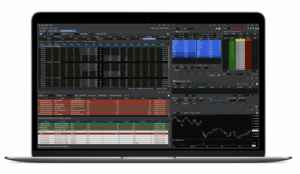Wall Street opened September on a negative note, with US stocks falling alongside bonds amid uncertainty about trade policy, interest rates, and economic data. At the close of trading on Tuesday, the Dow Jones Index (US30) dropped by 0.55%. The S&P 500 Index (US500) declined by 0.69%. The technology-heavy Nasdaq Index (US100) closed down by 0.82%. Rising Treasury yields added to the pressure, with 10-year yields approaching 4.3% and 30-year yields nearing 5%, which is seen as an unfavorable factor for equities. Sentiment was further dampened after a federal appeals court ruled that most of Trump’s tariffs were illegal, although they will remain in effect until October 14 pending a Supreme Court decision. Investors are now looking ahead to Friday’s August employment report, which could influence the Fed’s next rate decision, with markets currently expecting a 25-basis-point cut.
European stock markets were mostly down on Tuesday. The German DAX (DE40) fell by 2.29%, the French CAC 40 (FR40) closed down by 0.70%, the Spanish IBEX 35 (ES35) declined by 1.57%, and the UK’s FTSE 100 (UK100) closed down by 0.87%. European stocks closed sharply lower on Tuesday, following a broad sell-off in global equities amid rising long-term borrowing costs, as markets digested the latest inflation data. The Eurozone’s annual inflation rate edged up to 2.1%, while the core rate did not decrease for the third consecutive month, fueling persistent concerns about sticky service sector inflation. This data coincided with a new record for European bond issuance in a single session amid large sales in the UK and Italy, which put additional pressure on long-term securities.
WTI oil prices fluctuated around $65.7 per barrel on Wednesday, holding onto gains of more than 1% from the previous session, a rally supported by US sanctions and ongoing supply concerns. Washington recently imposed sanctions on shipping companies and vessels linked to an Iraqi-Kurdish businessman involved in transporting Iranian oil under the guise of Iraqi crude. Supply pressure also intensified after Ukrainian drones attacked facilities representing about 17% of Russia’s oil refining capacity. Meanwhile, traders are turning their attention to the September 7th OPEC+ meeting, though analysts do not expect any immediate changes to production levels.
Asian markets were mostly lower yesterday. Japan’s Nikkei 225 (JP225) rose by 0.29%, China’s FTSE China A50 (CHA50) gained 0.40%, Hong Kong’s Hang Seng (HK50) fell by 0.47%, and Australia’s ASX 200 (AU200) closed down by 0.30%.
Hong Kong stocks fell in early Wednesday trading, marking a second straight session of losses after a weak start on Wall Street the day before, where investors were assessing the outlook for President Donald Trump’s tariffs following a federal appeals court ruling that most of his sweeping measures were illegal. Further declines in mainland Chinese stocks also soured sentiment, even as a private survey showed that China’s composite PMI rose to a 9-month high in August, indicating a third consecutive month of private sector growth amid broad gains in manufacturing and services.
The Australian dollar was little changed at around $0.652 on Wednesday after falling by 0.5% in the previous session, as a strengthening US dollar offset optimistic domestic GDP data. On the domestic front, Australia’s economy grew by 0.6% in the second quarter, surpassing expectations of 0.5% and accelerating from a revised 0.3% in the first quarter, marking the 15th consecutive quarter of growth. Annual GDP also increased by 1.8%, the fastest growth since the third quarter of 2023, though investors remained cautious about the outlook, with market swaps indicating more than an 80% chance that the Reserve Bank of Australia will keep rates unchanged later this month.
A quarterly survey by the Monetary Authority of Singapore (MAS) revealed that economists have raised their 2025 growth expectations for Singapore and expect monetary policy to remain unchanged at the next review. The median growth expectations was raised from 1.7% in June to 2.4% after the government increased its 2025 projections range to 1.5%–2.5% in August, driven by stronger first-half results. Economists projections a 0.9% year-on-year growth for the third quarter. Geopolitical tensions were cited as the primary downside risk, while an easing of trade disputes and a pickup in the technology sector were named as key growth drivers.
On Wednesday, the New Zealand dollar held its recent decline at around $0.585 amid growing expectations of further policy easing by the Reserve Bank, given the weakness of the domestic economy. Recent data showed a sharp fall in export volumes in the June quarter, while import volumes rose significantly, indicating that trade likely had a major impact on GDP. Analysts now expect two more rate cuts, which would bring the rate down to 2.50%, the lowest level since mid-2022.








